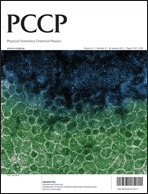Quantum effects in the abstraction reaction by H atoms of primary and secondary hydrogens in n-C4H10: a test of a new potential energy surface construction method
Abstract
Recently, von Horsten et al. suggested an efficient method to construct two dimensional potential energy surfaces (PESs) for use in quantum scattering simulations, in which they utilised the minimum energy path (MEP) and assumed harmonic behaviour of the PES near the MEP. In the same paper, the authors applied this method to various H-abstraction reactions from C1–C3 alkane molecules. In this work we demonstrate an alternative PES construction method, and apply it to the more challenging H-abstraction from n-C4H10 reactions. The geometry optimizations and frequency calculations are done at the MP2/cc-pVTZ level of theory, while the energies are calculated with the CCSD(T) method with the same basis set. The calculations give adiabatic energy barrier heights of 45.9 kJ mol−1 and 34.4 kJ mol−1 for the primary and secondary hydrogens in n-C4H10. When compared to purely classical transition state theory, quantum scattering calculations show that quantum tunnelling and zero-point effects have large contributions at low temperatures, typically below 500 K. The branching ratio study suggests that the abstraction of secondary hydrogen in n-C4H10 dominates the overall reaction rate at low temperatures. The rate constants for the two abstraction channels become more comparable as the temperature increases.

- This article is part of the themed collection: Celebrating our 2018 prize and award winners

 Please wait while we load your content...
Please wait while we load your content...